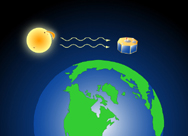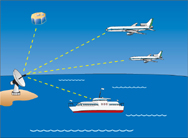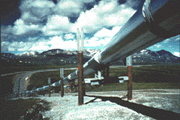Health, Safety, and Commercial Needs
Humans in Space
 |
Radiation exposure is a
real concern.
|
We know from studies that the principal space weather hazard to humans is radiation exposure. For missions that leave low-Earth orbit, the ability to predict solar energetic particle events as the craft passes through the planet's radiation belts is essential. While Earth's
atmosphere and magnetosphere allow adequate protection for us on the ground, astronauts in space are subject to potentially lethal dosages of radiation.
Although the atmosphere above an aircraft provides a measure of protection from cosmic rays and solar energetic particles that enter the magnetosphere, there is still concern for flights on polar routes during major solar particle events. Intense solar flares release high-energy particles
that can be as dangerous to humans as the low-energy radiation from nuclear blasts. Hazards to aircraft can be reduced by changing flight paths as necessary, and by limiting the flight time of the crew on high-altitude aircraft such as supersonic transports.
Communication and Navigation
 |
Solar storms cause damage to communication systems.
|
We are more and more dependent upon the advanced technological systems that orbit our planet. Global communications depend upon orbiting systems using high-frequency (HF), very high frequency (VHF), and ultra high frequency (UHF) radio signals. During geomagnetic storms some radio frequencies are
absorbed and others are reflected, leading to rapidly fluctuating signals and unexpected propagation paths (reproducing or multiplying in unplanned directions). Public and amateur radio is frequently disrupted.
Communications, navigation, and even land surveying via land, water, and air use global positioning systems (GPS) to determine routes and locations based on radio waves from satellites. And many communication systems use the ionosphere, an outer layer of our atmosphere, to reflect radio signals over long distances. Disturbances in the ionosphere cause time delays in signals travelling through
that atmospheric layer. These delays cause position errors and degrade the accuracy and reliability of GPS systems that are used for many range-finding and navigational purposes. Ionospheric irregularities produce "clutter" in radar signals.
 |
Solar storms cause damage to navigation systems.
|
Airplanes and ships using very low frequency signals from transmitters to determine their positions are adversely affected by solar activity. During solar events and geomagnetic storms, transmitter systems can give navigators information that is inaccurate by several miles. When alerted that a
geomagnetic storm is in progress, navigators can switch to backup systems.
Some military detection or early-warning systems are affected by solar activity. Over-the-horizon radar bounces signals off the ionosphere in order to monitor the launch of aircraft and missiles from long distances, but during geomagnetic storms this system can be severely hampered. The Federal Aviation Administration regularly receives alerts of solar radio bursts so they can schedule maintenance. And, when an aircraft and a ground station are aligned with the Sun, jamming of air-control radio frequencies can occur.
Power Systems
The enhanced currents that flow in the magnetosphere-ionosphere system during geomagnetic disturbances can affect electric power systems on the ground. For instance, on March 13, 1989, in Montreal, Quebec, six million people were without commercial electric power for nine hours as a result of a huge geomagnetic storm. Some areas in the northeastern United States and in Sweden also lost power.
These currents cause magnetic field disturbances on the ground that in turn induce, or move, other currents in long transmission lines, particularly ones at high latitudes. For example, the slowly varying "DC" part of the currents can be large enough to cause overheating and damage to systems designed for AC.
When magnetic fields move around near a conductor, such as a wire, an electric current is induced into the conductor, which happens on a grand scale during geomagnetic storms. Power companies transmit alternating current to their customers via long transmission lines. So, the nearly direct currents induced in power lines from geomagnetic storms are harmful to electrical transmission equipment.
 |
Hospital operating on auxillary power during blackout.
Source: New York Times.
|
Disruption of power systems can adversely affect our daily lives. Consider the consequences of a massive blackout in your area, such as the one that occurred in New York City in the summer of 1977. Early geomagnetic storm alerts and warnings can enable power companies to minimize damage and power outages.
Pipelines and Geomagnetic Surveys
 |
Solar storms cause problems
for engineers.
|
Rapidly fluctuating geomagnetic fields can induce, or move, currents into pipelines, causing a variety of problems for engineers. Dramatically increased pipeline corrosion is one affect. Such corrosion requires expensive repairs or can lead to permanent damage. And, if engineers attempt to balance the current during a geomagnetic storm, corrosion rates may increase even more. Pipeline managers routinely receive alerts and warnings to help them provide an efficient and long-lived system.
Geologists make use of Earth's magnetic field when searching for oil, gas, or mineral deposits, operating tools to detect magnetic signatures. This technique can usually be used only when Earth's magnetic field is quiet. But some geologists prefer to work during geomagnetic storms because variations to Earth's normal subsurface (underground) electric currents help them to see subsurface oil or mineral structures. Many surveyors use geomagnetic alerts and
predictions to schedule their mapping activities.
Geomagnetic surveys are important tools in the commercial exploration of natural resources. However, space weather disturbances can create signals in survey data that can be mistaken for signatures of subsurface resources. When this happens, survey schedules or operations mustbe modified, often at a significant cost.
Homing Pigeons
 |
Solar storms cause
pigeon racing "smashes."
|
Studies have been conducted on the Sun's effects on the navigational abilities of homing pigeons during geomagnetic storms. Pigeons and other migratory animals, such as dolphins and whales, have internal biological compasses composed of the mineral magnetite wrapped in bundles
of nerve cells. Although this probably is not a pigeon's primary method of navigation, researchers believe that this biological compass is affected by geomagnetic storms. One clue has been the many pigeon race "smashes"——a term used when only a small percentage of birds return
home from a release site. Because these losses have occurred during geomagnetic storms, pigeon handlers have learned to ask for geomagnetic alerts and warnings to aid in the scheduling of races.
Back